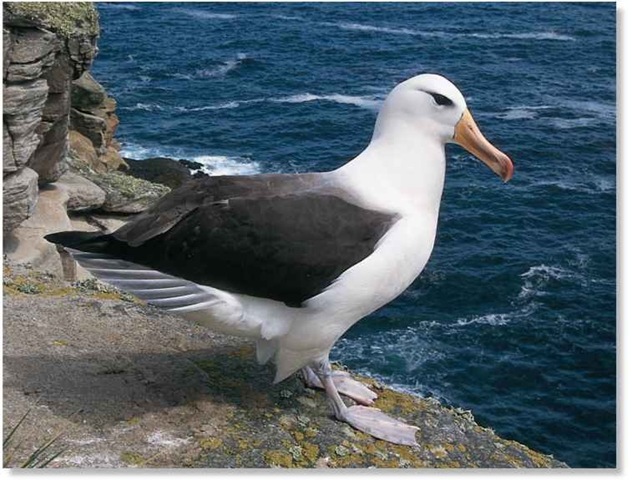ORDER
Procellariiform.es
FAMILY
Diomedeidae
GENUS & SPECIES
key features
• One of the largest flying seabirds, the black-browed albatross conserves energy by gliding with locked wings
• Lays one egg, much like its penguin relatives; chick has an exceptionally long period of flightless dependence
where in the world?
Widespread in the sub-Antarctic; breeds on cape Horn, staten Islands, Kerguelen, Heard, south Georgia and campbell Islands and the Falklands
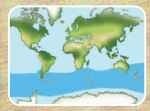
LIFECYCLE
Although it is a seabird, the black-browed albatross spends more time above the sea than in the frosty waters, descending only to feed and rest during its long migrations.
HABITAT
Spending little time on land or in the icy water; the black-browed albatross soars majestically above the Southern Hemisphere oceans and off the coasts of Australia; South America and Antarctica. Wave crests force wind upward; and the albatross remains in flight for hours on end; riding these air currents.
As Antarctic ice begins to break up during longer summer days; the black-browed albatross flies farther south. The warmer water contains millions of tiny shrimp; called krill; a staple of an albatross’s diet.
Highly migratory; the albatross flies up to 8,000 miles between mating seasons; seeking relatively moderate climates for breeding. It returns to the same nesting site each year, often sharing islands with penguins and gray-headed albatrosses.
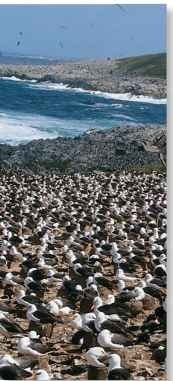
A Sunny islands Albatross nest in colonies on sub-Antarctic islands.
CONSERVATION
Longline fishing is currently a major threat to the future of the albatross. Longlines, stretching for several miles, are designed to catch bluefin tuna, but instead they attract at least a dozen species of albatross that go after the squidlike bait while feeding during their long migratory travels. It is estimated that every 12 minutes an albatross is snagged in the hooks and drowned. Approximately one million hooks are set yearly in the Southern Hemisphere.
FOOD & HUNTING
The black-browed albatross is an opportunistic hunter; roaming the seas for days at a time and seizing its prey from the water’s surface. By night it feeds on surface-skimming squid and cuttlefish. During the day the albatross hunts for fish and its favorite snack: krill, a shrimplike crustacean that swims in schools. It also feeds on the carcasses of dead seals and whales, and glides alongside ships and fishing boats in search of refuse. On occasion it dives underwater for its food.The black-browed albatross tops its meal off with a drink of seawater Paired salt glands behind the nostrils rid the black-browed albatross of excess salt; ducts from the glands then carry the concentrated saline solution to the nostrils. When the albatross “blows its nose” to expel the liquid, the tube-shaped nostrils project the solution away from the bird’s face, preventing it from hitting the albatross’s eyes.
aquatic opportunist
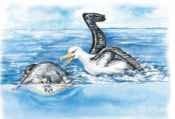
1 Floating…
With wings partially open for balance, the black-browed
albatross picks at the carcass of a king penguin.
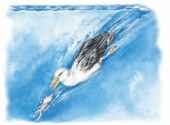
2 Diving…
Although the albatross prefers to feed near the surface, it may also plunge into the water after squid, a staple of its diet.
BREEDING
The black-browed albatross returns to land only to breed and constructs a nest on barren islands near the shore. Made of mud, the nest is a shallow cup on top of a small pedestal of soil and vegetation. Pairs bow their heads and rattle their beaks during mating rituals; they stay together for years and return to the same nest site year after yearAdults share incubation of the single white egg. Covered with brownish down, the hatched nestling matures slowly for four months.To feed their chick they regurgitate small, partially digested amounts that are easier for the nestling to accept. After fledging, the juvenile leaves the colony It reappears at the nesting site three years later, but will not breed until 5-10 years of age.

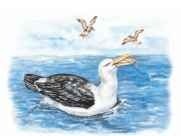
3 Gulping…
After swallowing the squid, the digestive process begins, so that back at the nest, the albatross can regurgitate for its hungry chick.
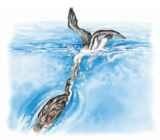
4 Stealing
A known pirate, the black-browed albatross routinely snatches fish from the beaks of other birds, including shags.
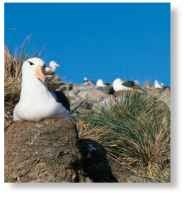
A Same Time,Next Year Stable pairs return to the same nest site each year.
The albatross often has great difficulty taking off and looks quite awkward, hence the nicknames “gooney” and “mollymawk,” Dutch for “foolish gull.”
Superstitious sailors believe killing an albatross brings bad luck; captured birds are usually released.
BEHAVIOR
The black-browed albatross is an avian nomad. A massive bird, this expert glider spends months wandering tremendous distances, sometimes thousands of miles, over the oceans. The albatross sleeps while floating in the water. After resting it takes flight with the wind, racing across the ocean’s surface until it’s clear of the waves. It climbs upward 60′ before curving downward, then zigzagging skyward, repeating this pattern for miles without a single wingbeat.
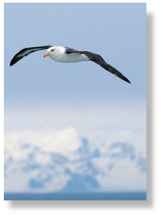
A Antarctic nomad An albatross wanders great distances for months.
Beak to beak
A chick, almost ready to fledge and begin its long aerial journeys, receives food from one of its parents.

PROFILE
Black-browed Albatross
The black-browed albatross glides around the Antarctic world with wings designed to take full advantage of air and eddy currents.
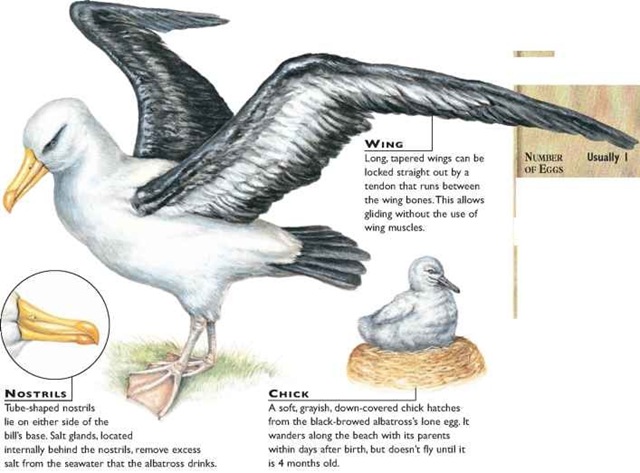
CREATURE COMPARISONS -
close relative of the black-browed albatross, the waved albatross (D. irrorata) measures ‘ almost 3′ long and is comparable in size but differs in colorThe black-browed albatross, I mainly white, has extensive black coloration on the underwings, combined with a long, black teardrop stripe through the eye.The waved albatross is a brownish bird with a white head and neck. Unlike the black-browed, the waved albatross lives north of the ‘ Black-browed albatross equator on the Galapagos Islands.
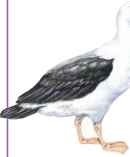
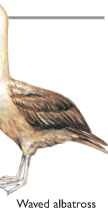
vital statistics
Up to 11 lbs.
Weight
Length
Wingspan
Sexual Maturity
Up to 3′ Up to 8′ 5-10 years
Breeding August-Season October
Incubation 70 days Period
Fledging Period
122-141 days I year
Breeding Interval
Typical Diet
Lifespan
Mainly squid, fish and krill
Up to 80 years
Related species
• Found mainly throughout the seas of the Southern Hemisphere, there are 14 species of albatross, the largest flying seabirds, in the genus Diomedea. The biggest is the wandering albatross, D. exulans, with a wingspan of more than 11.5′. The waved albatross, D. irrorata, is found only on Hood Island in the Galapagos. All species of albatross lay only one egg.
